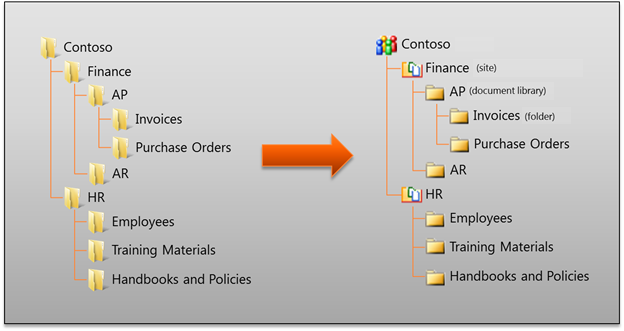File Share Librarian
The File Share Librarian is a capability within Metalogix StoragePoint that facilitates a shallow copy migration of content from file shares to containers in SharePoint, meaning content currently stored in file system-based shares can be represented in SharePoint as items, without being physically moved or uploaded into SharePoint. The Librarian simply creates items that point to the already externalized or remoted BLOBs. Once cataloged, they are treated by Metalogix StoragePoint like any other remoted BLOB would be treated.
In addition to cataloging the items on the source file share, the Librarian can also create a dynamic container structure within SharePoint. If a Web Application is used as the destination container in SharePoint, the Librarian will start by creating site collections for the first sub level folders in the file share, then sites at the next level, then libraries, and finally folders. For example, if a file share starting with a folder named Contoso is cataloged into a site collection in SharePoint it would look something like this:
As containers are created in SharePoint, the Librarian can apply permissions to them based on the effective permissions of the file share folders. It will map users and groups on the folders to the Owner (full control), Member (read/write), and Visitor (read only) roles in SharePoint.
File Share Librarian and File Shares
When using the File Share Librarian feature of Metalogix StoragePoint, it is important to understand that once a file share is cataloged by File Share Librarian, the file share is effectively under the control of SharePoint/Metalogix StoragePoint. Files on the file share may be modified or deleted depending on actions taken in SharePoint such as deleting files or removing folders, document libraries and cataloged sites.
For example, if the file is deleted in SharePoint and then purged from the SharePoint recycle bins, it will eventually be removed from the file share.
It is strongly recommended that a full backup of any cataloged file shares is taken before cataloging them with the File Share Librarian feature.
Also for this reason, any SharePoint Structure (Sites, Lists, libraries, folders) that are created as the result of cataloging should not be renamed in the SharePoint farm if it is expected that the librarian timer job may be run again at some point.
Librarian and New File Externalization
New content within the scope of the librarian configuration will need a non-librarian endpoint if there isnt one already on an existing profile for that scope; otherwise it will go to the content database. For example, if a librarian configuration is created that is pointing to a Content Database, but there is already a profile for the Web Application, the Future File Externalization Endpoint field will not be necessary; the endpoint that is already on the profile will be used. If the web app profile had only Librarian endpoints, the field will display on the Librarian configuration page. Conversely, if the Librarian configuration is going to result in the creation of a new profile where only the librarian endpoint is added, a second endpoint can be added to that profile while making edits on the librarian configuration page. New content is anything added after the content is cataloged, including versions of cataloged content.
File Share Librarian and System Cache
If there is a StoragePoint profile that uses RBS, System Cache must be configured in order to be able to add a Librarian configuration to the profile.
For example, if there is a profile for a content database that externalizes the data synchronously, and the plan is to catalog a file share to a site on that content database, system cache must be configured before creating the librarian configuration.

